
International Employment Laws
2025 Guide: Work Permits and Work Visas in Poland
Interested in working in Poland, or moving your whole team there? Here is what you need to know about work permits and visas for Poland.
Lucas Botzen
Global Employment Guides
10 mins read



Our Employer of Record (EOR) solution makes it easy to hire, pay, and manage global employees.
Book a demoThe way companies hire has fundamentally changed. They’re no longer limited by geography—teams today span continents, combining full-time employees in São Paulo with specialized contractors in Singapore. It’s an exciting shift, but also a complicated one.
Too many businesses jump into international hiring without understanding the critical differences between an Agent of Record (AOR) and an Employer of Record (EOR). The result can be compliance issues, unexpected fines, and misclassification risks that reach $100,000 per worker in some jurisdictions.
This guide explains what AOR and EOR mean, how they differ in practice, and when to use each model. Whether you’re testing a new market or scaling globally, understanding these distinctions is essential for compliant, sustainable growth.
At Rivermate, we’ve helped hundreds of companies make these decisions through a single, transparent platform that supports both AOR and EOR models.

Caption: “Rivermate’s Employer of Record (EOR) service makes global hiring simple, compliant, and stress-free.”
An Employer of Record (EOR) acts as your legal employment partner in countries where your company doesn’t have a local entity. The EOR becomes the official employer for your international team members, managing all legal, administrative, and compliance responsibilities required under local law.
Here’s how it works in practice:
Employment contracts and onboarding
An EOR prepares locally compliant employment contracts that meet each country’s legal requirements. They handle onboarding from start to finish, ensuring every new hire has the right documentation, benefits setup, and clarity before day one.
Labor laws vary widely: France requires defined probation periods, while Brazil mandates specific severance terms. The EOR ensures every contract meets those standards.
Payroll and tax management
Each country has unique payroll regulations, tax withholding rules, and reporting obligations. The EOR manages all of it, so employees are paid accurately and on time while staying compliant with tax authorities.
For example, in Germany, employers must withhold income tax, solidarity surcharges, and social security contributions, calculated differently from the US or UK.
As your team expands across borders, the role of a reliable global payroll partner becomes critical to maintaining accuracy and compliance.
While an employer of record (EOR) manages employees, an agent of record (AOR) supports a different kind of worker: independent contractors. An AOR acts as an intermediary between your company and contractors around the world, ensuring every engagement stays compliant, without converting contractors into employees.
Here’s what an AOR manages:
Contractor classification and documentation
An AOR verifies that each worker meets the legal definition of an independent contractor in their jurisdiction. It prepares compliant agreements that clearly outline the scope of work, payment terms, and independence of the relationship.
Definitions of contractor status vary—what qualifies as independent work in the Netherlands may be seen as disguised employment in Spain.
Invoice and payment facilitation
International payments can be slow and expensive. The AOR simplifies this by processing invoices and paying contractors through local banking channels.
A contractor in Argentina can be paid in pesos, while a designer in Thailand receives baht, without your finance team managing multiple currency accounts or wire transfers.
Tax documentation and compliance oversight
The AOR collects and maintains the required tax forms (such as [W-8BEN](https://www.irs.gov/pub/irs-pdf/fw8ben.pdf0 for non-U.S. contractors) and monitors ongoing compliance. It also tracks thresholds that could trigger reclassification, since, in many EU countries, exceeding certain hours or levels of control can reclassify a contractor as an employee.
What an AOR doesn’t do: provide benefits, assume employment liability, or create an employer-employee relationship. The contractor remains an independent business entity responsible for their own taxes, insurance, and operations.
Our Contractor of Record solution helps companies manage exactly these kinds of relationships while staying on the right side of local regulations.
Let’s look at how these two models differ in practice:
| Aspect | AOR (agent of record) | EOR (employer of record) |
|---|---|---|
| Worker type | Independent contractors | Full-time employees |
| Legal employer | Contractor remains independent | EOR becomes the legal employer |
| Tax responsibility | Contractor manages their own taxes | EOR withholds and remits taxes |
| Benefits administration | Not included (contractors manage their own) | Managed by EOR (health, pension, leave) |
| Compliance risk | Misclassification risk if the relationship becomes too employee-like | EOR assumes employment compliance risk |
| Typical use case | Project-based or short-term specialized work | Long-term or core team positions |
| Cost structure | Typically $50–$200 per contractor/month | Typically $300–$800 per employee/month |
| Flexibility | High—easy to scale up or down | Moderate—subject to employment laws |
Table caption: Key differences between an agent of record (AOR) and an employer of record (EOR)
The choice between an agent of record (AOR) and an employer of record (EOR) depends on the nature of your working relationship, project duration, and long-term hiring plans. Each model suits different stages of growth.
Use an AOR when:
Engaging specialized talent for defined projects
If you need short-term or project-based expertise, like a data scientist for a six-month analytics project or a designer for a brand refresh, AOR is the right fit. It gives you access to specialized skills without the long-term costs or commitments of employment.
Testing new markets before committing
When entering a new region, AOR allows you to engage local contractors to test product-market fit or explore new opportunities. You can evaluate performance and market potential before setting up a local entity or hiring employees through an EOR.
Scaling teams quickly and flexibly
AOR relationships can be established within one to two weeks. That speed makes it ideal for urgent projects or fluctuating workloads where flexibility is key. Contractors can be onboarded, paid, and managed compliantly through a single platform.
Use an EOR when:
Building long-term teams
If you’re hiring people who will work with you for the long term, treat them as employees. An EOR manages legal employment, payroll, and benefits so your core team members can work securely and compliantly from anywhere.
Ensuring full compliance and stability
When roles involve ongoing collaboration, fixed schedules, or use of company tools and systems, EOR is the safer and often required option. It protects your company from misclassification risk and gives employees access to local benefits.
Establishing a permanent presence
If your company plans to build lasting operations in a new market, an EOR helps you hire immediately while you decide whether to set up a local entity. It’s a compliant bridge for growing markets or teams of 10–20 employees before formal incorporation
Let's talk about cost, because global hiring decisions ultimately need to make financial sense for your business.
AOR pricing typically includes:
Per-contractor service fees ranging from $50-$200 per contractor per month depending on the country and service level
One-time onboarding costs ($100-$300 per contractor)
Payment processing fees (often 1-3% for currency conversion)
No benefits costs (contractors handle their own)
Example:
If you pay a contractor $5,000 per month, your total cost, including AOR fees, might be between $5,150 and $5,400.
EOR pricing typically includes:
Flat monthly rate per employee ($300-$800 depending on country complexity)
Setup/onboarding fees ($500-$1,500 per employee)
All payroll processing, tax withholding, and compliance monitoring
Benefits administration (health insurance, retirement, paid leave)
Legal support and employment risk management
Example:
If you pay an employee a base salary of $5,000 per month, your total monthly cost could range from $6,500 to $7,500, including EOR fees and statutory benefits (typically 20–35% of salary).
The hidden cost trap:
Some providers advertise low base rates but add extra charges later. Common hidden costs include:
Per-payroll “administration” fees ($50–$150 each)
Charges for benefits setup ($200–$500 per employee)
Currency conversion markups (2–4% on each transaction)
Platform access or minimum-commitment fees
Termination or offboarding fees
At Rivermate, we've built our model differently. Our pricing is flat-rate and transparent. There are no hidden administrative costs, currency markups, or surprise charges. What you see is what you pay, so you can forecast global hiring costs with confidence.
The right choice depends on how you plan to work with global talent.
Choose AOR if you’re engaging independent contractors for short-term or project-based work. It gives you flexibility and speed while maintaining compliance.
Choose EOR if you’re hiring full-time employees who will work long-term, need benefits, or fall under local employment laws. It provides structure, protection, and stability.
Both models have their place, and using the right one at the right time is what keeps your business compliant and scalable.
With Rivermate, you don’t have to choose between AOR and EOR. Our platform brings both models together under one partner, one contract, and one global compliance standard.
Book a demo to see how Rivermate simplifies international hiring, so you can grow your global team with confidence.
An agent of record (AOR) manages independent contractors, ensuring contracts, payments, and tax documentation comply with local laws.
An employer of record (EOR) legally employs full-time workers on your behalf, managing payroll, benefits, and compliance.
Yes. Many global businesses use an AOR for contractors and an EOR for full-time employees. This hybrid approach allows flexibility in workforce planning while staying compliant in every country.
Generally, yes. An AOR costs less because it doesn’t cover employee benefits or assume employment liability. An EOR includes payroll, benefits, taxes, and compliance management, making it more comprehensive but also higher in cost.
Rivermate combines AOR and EOR capabilities on one platform. It manages contractors through local AOR structures and full-time employees through EOR entities, covering over 160+ countries. This unified system ensures compliant hiring, predictable pricing, and seamless global workforce management.

Lucas Botzen is the founder of Rivermate, a global HR platform specializing in international payroll, compliance, and benefits management for remote companies. He previously co-founded and successfully exited Boloo, scaling it to over €2 million in annual revenue. Lucas is passionate about technology, automation, and remote work, advocating for innovative digital solutions that streamline global employment.


Our Employer of Record (EOR) solution makes it easy to hire, pay, and manage global employees.
Book a demo
International Employment Laws
Interested in working in Poland, or moving your whole team there? Here is what you need to know about work permits and visas for Poland.
Lucas Botzen

International Employment Laws
Want to move your team to Germany? Read on to find out all there is to know about work permits and visas in Germany.
Vladana Donevski

International Employment Laws
Want to live and work among the Dutch? Here is all you need to know about work permits and visas for the Netherlands.
Lucas Botzen